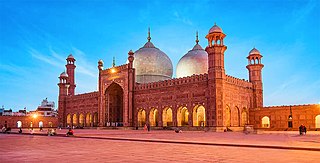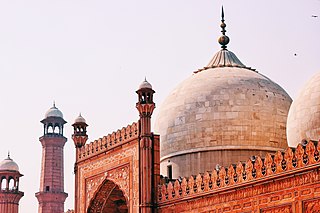
Lahore is the capital and largest city of the Pakistani province of Punjab. It is the second largest city in Pakistan, after Karachi, and 26th largest in the world, with a population of over 13 million. Located in central-eastern Punjab, along the River Ravi, it is the largest Punjabi-speaking city in the world. Lahore is one of Pakistan's major industrial, educational and economic hubs. It has been the historic capital and cultural centre of the wider Punjab region, and is one of Pakistan's most socially liberal, progressive, and cosmopolitan cities.

The Lahore Fort is a citadel in the city of Lahore in Punjab, Pakistan. The fortress is located at the northern end of the Walled City of Lahore and spreads over an area greater than 20 hectares. It contains 21 notable monuments, some of which date to the era of Emperor Akbar. The Lahore Fort is notable for having been almost entirely rebuilt in the 17th century, when the Mughal Empire was at the height of its splendor and opulence.

Minar-e-Pakistan is a tower located in Lahore, Punjab, Pakistan. The tower was built between 1960 and 1968 on the site where the All-India Muslim League passed the Lahore Resolution on 23 March 1940 – the first official call for a separate and independent homeland for the Muslims of British India, as espoused by the two-nation theory. The resolution eventually helped lead to the creation of Pakistan in 1947.

The Architecture of Lahore reflects the history of Lahore and is remarkable for its variety and uniqueness. There are buildings left from the centuries of rule of the Mughal Empire, the Sikh Empire, as well as from the era of the British Raj, whose style is a mixture of Victorian and Islamic architecture often referred to as Indo-Saracenic. In addition, there are newer buildings which are very modern in their design. Unlike the emphasis on functional architecture in the west, much of Lahore's architecture has always been about making a statement as much as anything else.
The Qutb Minar, also spelled Qutub Minar and Qutab Minar, is a minaret and "victory tower" that forms part of the Qutb complex, which lies at the site of Delhi's oldest fortified city, Lal Kot, founded by the Tomar Rajputs. It is a UNESCO World Heritage Site in the Mehrauli area of South Delhi, India. It was mostly built between 1199 and 1220, contains 399 steps, and is one of the most visited tourist spots in the city. Qutab-ud-din Aibak initiated construction of the Qutub Minar, but only managed to finish the first level. His later rulers continued the construction, and in 1368, Firuz Shah Tughlaq rebuilt the top parts and added a cupola.

The Shaheed Minar is a national monument in Dhaka, Bangladesh, established to commemorate those killed during the Bengali Language Movement demonstrations of 1952 in then East Pakistan.

Mughal architecture is the type of Indo-Islamic architecture developed by the Mughals in the 16th, 17th and 18th centuries throughout the ever-changing extent of their empire in the Indian subcontinent. It developed from the architectural styles of earlier Muslim dynasties in India and from Iranian and Central Asian architectural traditions, particularly Timurid architecture. It also further incorporated and syncretized influences from wider Indian architecture, especially during the reign of Akbar. Mughal buildings have a uniform pattern of structure and character, including large bulbous domes, slender minarets at the corners, massive halls, large vaulted gateways, and delicate ornamentation; examples of the style can be found in modern-day Afghanistan, Bangladesh, India and Pakistan.
Pakistan has several official national symbols, including a flag, an emblem, an anthem, a memorial tower as well as several national heroes. The symbols were adopted at various stages in the existence of Pakistan and there are various rules and regulations governing their definition or use. The oldest symbol is the Lahore Resolution, adopted by the All India Muslim League on 23 March 1940, and which presented the official demand for the creation of a separate country for the Muslims of India. The Minar-e-Pakistan memorial tower which was built in 1968 on the site where the Lahore Resolution was passed. The national flag was adopted just before independence was achieved on 14 August 1947. The national anthem and the state emblem were each adopted in 1954. There are also several other symbols including the national animal, bird, flower and tree.

Vedat Dalokay was a Turkish architect and a former mayor of Ankara.

Chauburji is a Mughal era monument in the city of Lahore, capital of the Pakistani province of Punjab. The monument was built in 1646 C.E. during the reign of the emperor Shah Jahan. It previously acted as a gateway to a large garden.

The Pakistan Monument is a national monument and heritage museum located on the western Shakarparian Hills in Islamabad, Pakistan. The monument was constructed to symbolize the unity of the Pakistani people. It is dedicated to the people of Pakistan who sacrificed their "today" for a better "tomorrow".
The Bab-e-Pakistan is a national monument in Lahore, Punjab, Pakistan which is being built on the site of one of the major Muslim refugee camps which operated in the aftermath of independence of Pakistan.
Pakistani architecture is intertwined with the architecture of the broader Indian subcontinent. The major architectural styles popular in the past were Temple, Indo-Islamic, Mughal and Indo-Saracenic architecture, all of which have many regional varieties. With the beginning of the Indus civilization around the middle of the 3rd millennium BC, for the first time in the area which encompasses today's Pakistan an advanced urban culture developed with large structural facilities, some of which survive to this day. This was followed by the Gandhara style of Buddhist architecture that borrowed elements from Ancient Greece. These remnants are visible in the Gandhara capital of Taxila.

Charing Cross, officially known as Faisal Chowk, is a major road intersection in Lahore, Punjab, Pakistan. Located on Shahrah-e-Quaid-e-Azam, it is a popular site for protests within Lahore.

The WAPDA House is a nine-story office building located in Lahore, Pakistan, that serves as the headquarters of the Water and Power Development Authority (WAPDA). It is one of several prominent government buildings located at Charing Cross on Lahore's Mall Road, officially known as Shahrah-e-Quaid-e-Azam. The building shares views of the Punjab Provincial Assembly, Islamic Summit Minar, Masonic Lodge, and other key landmarks.

Nasreddin Murat-Khan was a Russian-born Pakistani architect and civil engineer. He is renowned for designing the iconic national monument, the Minar-e-Pakistan. He was also the architect of the Gaddafi Stadium and several other notable buildings and structures.

The Badshahi Mosque is a Mughal-era imperial mosque located in Lahore, Punjab, Pakistan. It was constructed between 1671 and 1673 during the rule of Aurangzeb, opposite of the Lahore Fort on the northern outskirts of the historic Walled City. It is widely considered to be one of the most iconic landmarks of the Punjab.
The following is a timeline of the history of the city of Lahore, Pakistan.

The Javed Manzil or the Allama Iqbal Museum is a monument and museum in Lahore, Pakistan. Muhammad Iqbal lived there for three years, and died there. It was listed as a Tentative UNESCO site, and was protected under the Punjab Antiquities Act of 1975, and declared a Pakistani national monument in 1977. In honour of Iqbal, a Pakistani national poet, it was converted into a museum, inaugurated in December 1984.

Punjab is the largest province in population and the second largest province in physical size in Pakistan. In 2017, 1.75 million tourists visited Pakistan according to the World Travel and Tourism Council.

















